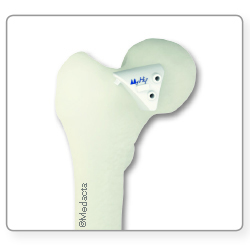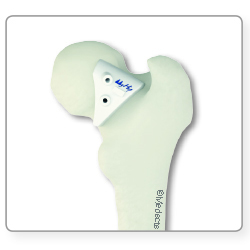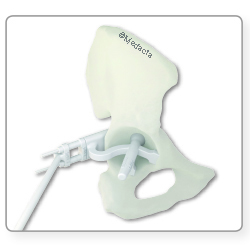
Precision
on demand
The MyHip is an advanced system specifically designed to assist the surgeon with implant selection and positioning[1], addressing the challenges in total hip replacement and streamlining the pathway to a carefully planned procedure, through:
3D preoperative planning[2,3] which can halve the number of alignment outliers when compared to 2D templating.[4,5]
3D printed patient-specific guides[6,7,8] which can reproduce the 3D preoperative plan.

MyHip 3D preoperative planning is based on the surgeon preferences and patient anatomy. The plan is submitted to the surgeon for approval through an interactive website available at
For each case, the surgeon can modify implant type, size and position, to further improve precision of the preoperative plan.
Following surgeon approval of the 3D preoperative plan, Medacta produces the MyHip 3D Printed Patient-Specifc Guides using in-house laser sintering technology.
MyHip 3D Printed Patient-Specific Guides are designed to accurately reproduce the surgeon approved preoperative plan.
MyHip 3D Printed Patient-Specific Guides are:
ANTERIOR FEMORAL GUIDE

POSTERIOR FEMORAL GUIDE

POSTERIOR ACETABULAR GUIDE

To ASSIST THE SURGEON with implant selection and positioning using 3D PREOPERATIVE PLANNING and 3D PRINTED PATIENT-SPECIFIC GUIDES.
ONLY 3 WEEKS LEAD TIME
The shortest delivery time in the market today for this technology.
A PERSONAL MYHIP TECHNICIAN TO WORK WITH
Each surgeon is assigned a personal MyHip technician to develop a direct relationship and familiarisation with the surgeon preferences.
ONLINE CASE MANAGEMENT
MyHip cases are managed entirely online with no need to install software. The cases database is available to the surgeon at any time, from anywhere and the information on the website is always kept up-to-date.
COMPLETE IN-HOUSE TECHNOLOGY
The MyHip process is kept entirely in-house, from the 3D anatomical reconstruction to the manufacture of the 3D printed patient-specific femoral and acetabular guides, allowing direct contact between the surgeon and his/her personal MyHip technician.

Medacta receives the CT images of the patient‘s leg.
MyHip preoperative planning commences with the 3D reconstruction of the joint following the surgeon’s preferences.


Virtual positioning of the implant is proposed to the surgeon, who can modify this planning, if required.
Once the planning has been validated by the surgeon, the in-house 3D printing manufacturing process starts.

MyHip delivers a system specifically designed for each patient and intended for use with Medacta implants exclusively, in order to achieve more accurate total hip replacement.

MyKnee is a patient-specific cutting block, allowing the surgeon to realize his pre-operative 3D planning, based on CT or MRI images of the patient’s knee. This innovative concept combines different features giving potential benefits to both the surgeon and to the patient.

MySpine is a patient specific pedicle screw placement guide, allowing the surgeon to determine his pre-operative 3d planning, based on CT images of the patient’s spine. This innovative concept combines several different features to offer potential benefits to both the surgeon and the patient.

MyShoulder is a patient-specific instrumentation, allowing the surgeon to realize his pre-operative 3D planning, based on CT images of the patient’s shoulder. The pre-operative 3D planning allows to manufacture an humeral resection guide and a glenoid positioning guide.This innovative concept combines different features giving potential benefits to both the surgeon and to the patient.
An advanced network of digital solutions designed to improve patient outcomes and healthcare efficiency
[1] Schmid J., Chênes C., Chagué S., Hoffmeyer P., Christofilopoulos P., Bernardoni M., Charbonnier C. MyHip: supporting planning and surgical guidance for a better total hip arthroplasty. Int J Comput Assist Radiol Surg. 2015 Oct;10(10):1547-56.
[2] Müller ME. Total hip replacement: planning, technique and complications. In: Surgical management of denegerative arthritis of the lower limb. Philadelphia: Lea and Faber., 1975:90-113.
[3] Müller ME. Lessons of 30 years of total hip arthroplasty. Clin Orthop 1992;274:12-21.
[4] Sariali E, Mouttet A, Pasquier G, Durante E, Catone Y. Accuracy of reconstruction of the hip using computerised three-dimensional pre-operative planning and a cementless modular neck. J Bone Joint Surg [Br] 2009;91-B:333-40.
[5] Sariali E, Mauprivez R, Khiami F, Pascal-Mousselard H, Catonné Y. Accuracy of the preoperative planning for cementless total hip arthroplasty. A randomised comparison between three-dimensional computerised planning and conventional templating. Orthop Traumatol Surg Res. 2012 Apr;98(2):151-8.
[6] Small T, Krebs V, Molloy R, Bryan J. Comparison of Acetabular Shell Position Using Patient Specific Instruments vs. Standard Surgical Instruments: A Randomized Clinical Trial. J Arthroplasty. 2013 Oct 16.
[7] Buller L, Smith T, Bryan J, Klika A, Barsoum W. The use of patient-specific instrumentation improves the accuracy of acetabular component placement. J Arthroplasty. 2013 Apr;28(4):631-6.
[8] Hananouchi T, Saito M, Koyama T, Sugano N, Yoshikawa H.Tailor-made Surgical Guide Reduces Incidence of Outliers of Cup Placement. Clin Orthop Relat Res. 2010 Apr;468(4):1088-95.